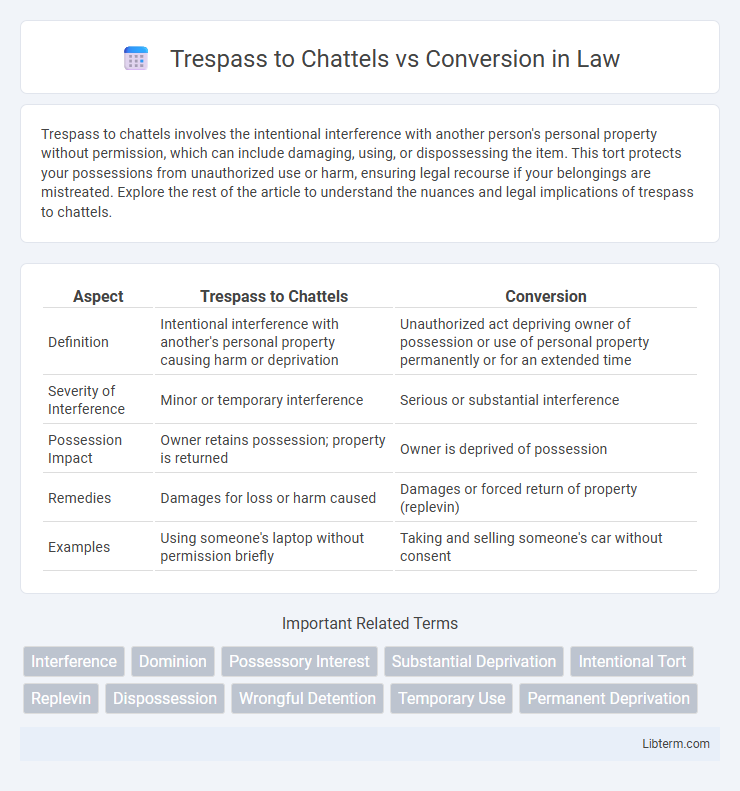Trespass to chattels involves the intentional interference with another person's personal property without permission, which can include damaging, using, or dispossessing the item. This tort protects your possessions from unauthorized use or harm, ensuring legal recourse if your belongings are mistreated. Explore the rest of the article to understand the nuances and legal implications of trespass to chattels.
Table of Comparison
| Aspect | Trespass to Chattels | Conversion |
|---|---|---|
| Definition | Intentional interference with another's personal property causing harm or deprivation | Unauthorized act depriving owner of possession or use of personal property permanently or for an extended time |
| Severity of Interference | Minor or temporary interference | Serious or substantial interference |
| Possession Impact | Owner retains possession; property is returned | Owner is deprived of possession |
| Remedies | Damages for loss or harm caused | Damages or forced return of property (replevin) |
| Examples | Using someone's laptop without permission briefly | Taking and selling someone's car without consent |
Understanding Trespass to Chattels
Trespass to chattels involves intentional interference with another person's movable personal property that causes harm or deprivation of use, but not to the extent of total deprivation or destruction. This tort requires proof of actual damage or interference, distinguishing it from conversion, which involves a serious and unlawful taking or control over the property amounting to ownership rights. Understanding trespass to chattels is crucial in cases where property is temporarily or slightly impaired, ensuring protection without granting full ownership claims.
Defining Conversion in Law
Conversion in law refers to an intentional act by one party that interferes with another's lawful possession of personal property, effectively depriving the owner of their rights. It entails exercising unauthorized control over the chattel, often equated with theft or unauthorized use, which causes substantial damage or deprivation. Conversion distinguishes itself from trespass to chattels by the degree of interference, requiring a more serious invasion that warrants the full value of the property as damages.
Key Differences Between Trespass to Chattels and Conversion
Trespass to chattels involves the intentional interference with another's personal property that causes harm or deprivation of use, but typically without complete destruction or permanent deprivation. Conversion, on the other hand, constitutes an act that seriously interferes with the owner's rights, often resulting in the complete deprivation or destruction of the property, warranting full replacement value damages. The primary difference lies in the severity of interference and damages sought: trespass to chattels claims usually seek compensation for actual damage or loss of use, while conversion claims seek the full value of the property due to extensive interference.
Essential Elements of Trespass to Chattels
Trespass to chattels requires intentional interference with another person's personal property that causes dispossession, damage, or deprivation of use for a substantial time. Essential elements include intentional interference with the chattel, actual possession or right to possession by the plaintiff, and resulting harm or impairment to the chattel's condition, quality, or value. Unlike conversion, which involves dominion or control over the property inconsistent with the owner's rights, trespass to chattels involves lesser interference without total deprivation.
Essential Elements of Conversion
Conversion involves the unauthorized exercise of dominion over another's personal property, depriving the owner of their rights permanently or for an extended period. Essential elements include the plaintiff's valid ownership or right to possession, the defendant's intentional interference or control over the property, and the resulting significant deprivation or damage to the property. Distinct from trespass to chattels, conversion requires a substantial interference that justifies the full value recovery of the property.
Examples Illustrating Trespass to Chattels
Trespass to chattels occurs when someone intentionally interferes with another's personal property without consent, such as temporarily using another person's laptop without permission or removing a smartphone from their possession without causing permanent damage. Unlike conversion, which involves an unauthorized act depriving the owner of their property permanently or for an extended period, trespass to chattels involves lesser interference causing limited harm. An example includes someone borrowing a car without consent and returning it undamaged after a short time, illustrating trespass to chattels rather than conversion.
Examples Demonstrating Conversion
Examples demonstrating conversion include forcibly taking someone's car without permission, selling another person's laptop without consent, and withholding a borrowed item beyond the agreed-upon time. Conversion involves an unauthorized act that deprives the owner of possession or use of their personal property, significantly interfering with their ownership rights. Trespass to chattels, by contrast, refers to minor or temporary interference without intent to exercise ownership.
Legal Remedies for Trespass to Chattels
Legal remedies for trespass to chattels primarily involve monetary damages to compensate for the interference with possessory rights or the actual harm caused to the chattel. Courts may award damages for loss of use, diminution in value, or costs of repair, but typically do not permit recovery of the chattel itself, distinguishing it from conversion claims. Injunctive relief may also be granted to prevent ongoing or future interference with the chattel.
Legal Remedies for Conversion
Legal remedies for conversion primarily include compensatory damages aimed at restoring the plaintiff's value of the converted chattel. Courts may also award consequential damages for additional losses caused by the conversion, such as lost profits. In some cases, injunctive relief can be sought to prevent further harm or to recover possession of the property.
How Courts Distinguish Between Trespass to Chattels and Conversion
Courts distinguish trespass to chattels from conversion primarily based on the extent of interference with the plaintiff's personal property rights. Trespass to chattels involves minor or temporary interference without depriving the owner of possession, often warranting damages for harm caused. Conversion requires a substantial interference that deprives the owner of possession or use of the property, treated as a forced sale and typically resulting in the full value of the chattel as damages.
Trespass to Chattels Infographic

 libterm.com
libterm.com